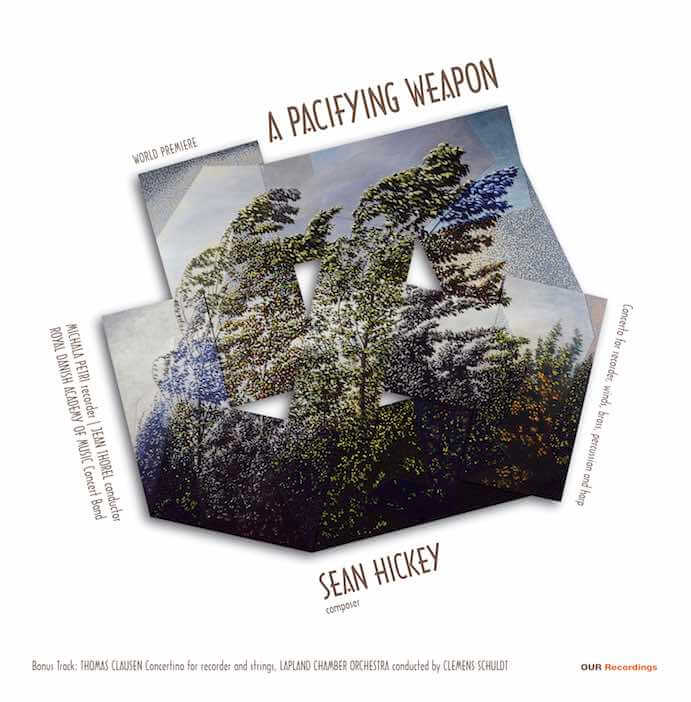Music relies on listeners’ expectations to present its material—a kind of portable structure that goes from piece to piece, and changes over time. Composers and performers either meet or subvert those expectations in the music that they write. Some do so intentionally, while others do not. Composers and performers in the twenty-first century make it their business to challenge the forms and functions of the classical canon, and generally give every norm they encounter a new voice. A Pacifying Weapon (OUR Recordings) does this with great success, striking an excellent balance between tradition and innovation by writing in established forms for uncommon combinations of instruments without adding electronic elements. The recorder is the unquestioned star of this album, and soloist Michala Petri has a clear command of both its technique and of composer Sean Hickey‘s vision for its more modern voice. She also carries the more traditional Concertino for Recorder and Strings by Thomas Clausen with grace and poise.
Petri commissioned the title composition, A Pacifying Weapon, in 2015. Though not titled as a concerto, Hickey wrote it as such and used it to “wrestle with the concerto tradition and its complications.” He kept many of the structures that make a concerto recognizable: three distinct movements presented in a fast-slow-fast succession; alternating between solo instrument and accompaniment ensemble passages. Hickey wrote for the Royal Danish Academy of Music (RDAM) winds as a constantly fluctuating chamber group. His accompaniment has a clear yet subtle influence from film music: a chord here, a specific orchestration there; never a direct quote. The brass is limited to section chorales that, even when quiet, sound enormous. The result is atmospheric, and about as far from traditional recorder music as one might get.
Sean Hickey
This mix of exposed passages and chamber writing in the accompaniment creates the kind of space the solo recorder needs, and this is also where Hickey departs from the traditional concerto structure. The first movement is more of a tone poem with a significant soloist. The soloist’s virtuosity is excellent–Petri plays clearly and confidently in long technical passages (obligatory, for a concerto), but doesn’t default to “noodling” in cadenza and unaccompanied passages. She has an obvious command of the recorder’s capabilities beyond notes per minute, and it’s gratifying to listen to an artist explore the virtuosity of simplicity as well as of technicality. Particularly in the second movement, Hickey writes in sustained tones that Petri has to keep interesting throughout, and this requires a less-celebrated brand of artistry.
The third movement is where Hickey really puts the recorder and the concerto form through their respective paces. Instead of a more traditional show piece, the third movement is a character study. The brass chorales are still traditional, but they’ve traded their earlier sedateness for an angular, urgent tension. The recorder is capricious—like a character out of Shakespeare, popping in and out of the scenery. The use of bass recorder in the middle section is a departure from everything else so far. It alternates between the ethereal and the striking, with an intensity that recalls Feldman and Boulez. The final fast section calls back to the recorder as a folk instrument. The accompanying percussion and winds are short, light, and closely orchestrated—punctuation for the soloist’s final remarks.
Michala Petri–Photo by Svend Withfelt
Thomas Clausen‘s Concertino for Recorder and Strings provides a much more traditional context for the recorder. Clausen’s solo writing owes much to clarinet repertoire, providing a very different role for Petri to play than those in in A Pacifying Weapon. The middle section could be Baroque, but for its more modern benefits (like extra cellos and basses). The final presto owes many of its mannerisms to Mozart and Rossini, though in a contemporary landscape. Whether these are conscious allusions by the composer or whether he is simply well-schooled in classical repertoire is hard to tell. In the end, it doesn’t really matter. It is light, humorous, exciting, and a technical tour de force—an excellent counterpoint to Hickey’s previous piece.
The album in total strikes an excellent balance of fulfilling and subverting its listeners expectations, both of the recorder and of the concerto. Having a period instrument play in a contemporary context breaks the recorder’s norm and adds a new dimension to its largely historical repertoire. The music, the soloist, and the student musicians of the RDAM are all genuinely impressive, and they’ve produced an excellent recording worth regularly revisiting.

